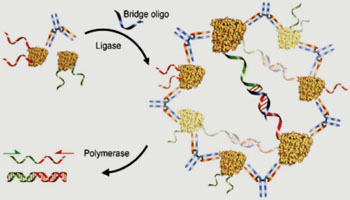Ultrasensitive Antibody Detection Enabled by Agglutination-PCR
By LabMedica International staff writers
Posted on 14 Mar 2016
Antibodies are widely used biomarkers for the diagnosis of many diseases and assays based on solid-phase immobilization of antigens comprise the majority of clinical platforms for antibody detection, but can be undermined by antigen denaturation and epitope masking. Posted on 14 Mar 2016
These technological hurdles are especially troublesome in detecting antibodies that bind nonlinear or conformational epitopes, such as anti-insulin antibodies in type 1 diabetes patients and anti-thyroglobulin antibodies associated with thyroid cancers.
Scientists at the University of California, Berkeley (CA, USA) and their colleagues developed an ultrasensitive solution-phase method for detecting antibodies, termed antibody detection by agglutination-polymerase chain reaction (PCR) (ADAP). Antibodies bind to and agglutinate synthetic antigen-DNA conjugates, enabling ligation of the DNA strands and subsequent quantification by qPCR. Previous applications of proximity ligation share the common format of using DNA-conjugated antibodies to detect an analyte of interest. ADAP inverts this scenario, using a DNA-conjugated antigen for detection of antibodies.
The assay exploits the intrinsic multivalency of antibodies to drive the proximity effect. The impressive dynamic range of ADAP appears related to the ability of antibodies to aggregate their antigens, as suggested by the superior performance of poly- versus monoclonal antibodies .This mechanism is unique to antibody detection and to ADAP and the qPCR was performed on either a Bio-Rad CFX96 or a Bio-Rad iQ5 real-time PCR detection system (Bio-Rad Laboratories, Inc., Hercules, CA, USA). The approach only requires a minute sample of patient blood and is 1,000 times more sensitive in detecting biomarkers for thyroid cancer than the current government-approved test.
The authors concluded that ADAP opens the possibility of performing all three types of tests (genome-derived nucleic acids, antigens, and antibodies) in a unified platform. ADAP could also be easily adapted to any number of novel point-of-care PCR platforms to provide highly sensitive solution phase antibody tests in low resource settings. Because of these favorable attributes, its operational simplicity, and the leveraging of existing technology, they predict that ADAP will provide a useful analytical platform for a multitude of clinical and research applications. The study was published on February 16, 2016, in the journal ACS Central Science.
Related Links:
University of California, Berkeley
Bio-Rad Laboratories Inc.













.jpg)

